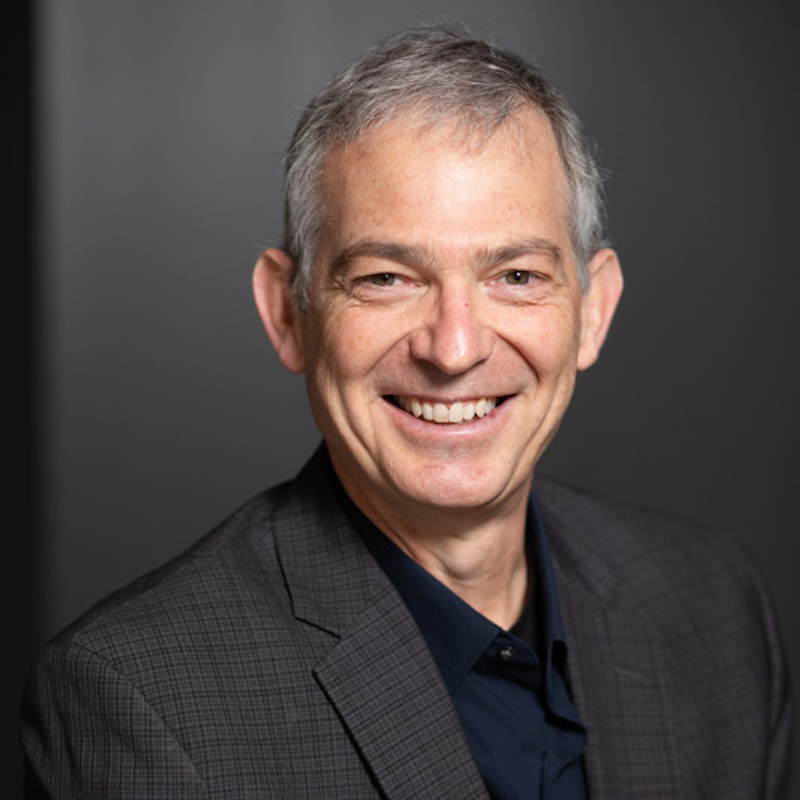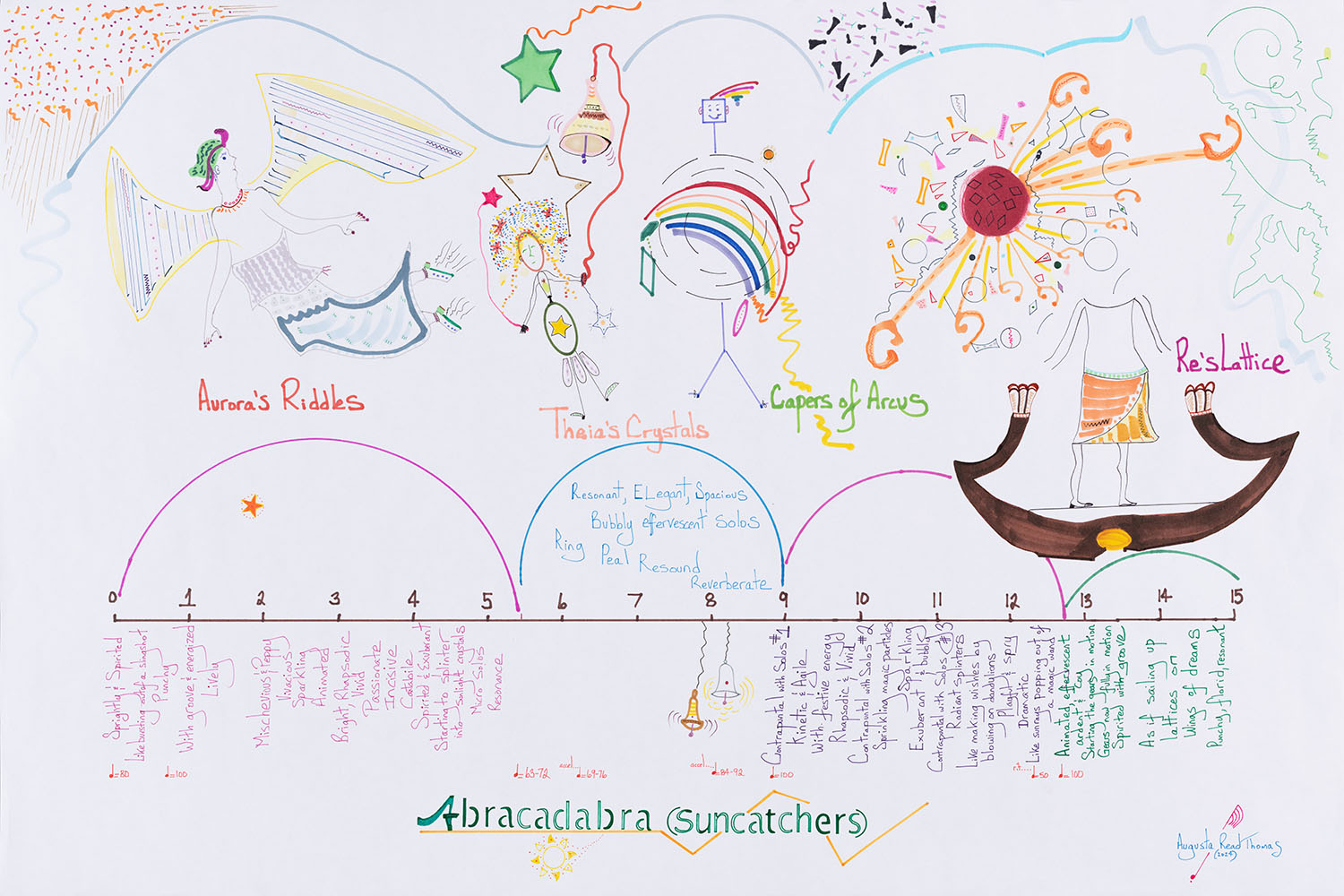Fl., Cl.1, Cl.2, Bn.*, 2 Perc., Pno., 2 VL, VA, and VC. (Or, instead of string quartet: 33330)
*(or Baritone Saxophone in E♭+ for which pitches Bb1 and B1 have been raised by one octave in the part.)
First performance by the Aspen Contemporary Ensemble conducted by Timothy Weiss on 17 August 2024 in Harris Concert Hall at the Aspen Music Festival, Aspen, Colorado.
Sasha Ishov, Flute; Clayton Luckadoo, Yan Liu, Clarinets; Kahlan Yenney, Bassoon; Reed Puleo, Cameron Marquez, Percussion; Liam Kaplan, Piano; Herdís Guðmundsdóttir, Laura Gamboa, Violins; Felix Veser, Viola; and Miles Reed, Cello.
UK premiere by the Manson Ensemble conducted by Timothy Weiss on 19 October 2024, at the Royal Academy of Music, London.
Duration: 15 minutes (Five optional shorter duration versions are clearly marked in the score, ranging from 5’30” to 12’30”)
Dedicated with admiration and gratitude to Timothy Weiss, the Aspen Contemporary Ensemble and the Aspen Music Festival, and the Oberlin Conservatory of Music.
Abracadabra (Suncatchers) for 11 virtuosi live concert recoding by the Aspen Contemporary Ensemble conducted by Timothy Weiss
Co-commissioned by Aspen Music Festival and School, Robert Spano, Music Director and Oberlin class of 1984, and Oberlin Conservatory of Music.
I: AURORA’S RIDDLES
Sprightly and spirited –
In Roman mythology, the goddess Aurora renews herself every morning and flies across the sky, announcing the arrival of the sun. Aurora is imagined here as an enchanter performing magic tricks.
II: THEIA’S CRYSTALS
Resonant, elegant, and spacious –
In Greek mythology, Theia is the ancient goddess of sight and the glittering bright sky. She was mother of Helios, Selene, and Eos. Her name itself means Goddess. Here, some magic ritual of incandescent sky is unfolding as each new resonant bell reverberates and shimmers back to silence conjuring and spinning off webs of sun threads.
III: CAPERS OF ARCUS
Kinetic and agile –
In Roman mythology, Arcus personifies the rainbow and is known as the goddess of rainbows. A rainbow, which is a display of the colors of the spectrum produced by dispersion of light, often stands for hope and can refer to something much sought after and hard to attain. “Chasing rainbows” can be to pursue an illusory goal. Arcus is imagined here as crafting capers while chasing rainbows. [Capers definitions: verb: dances, skips, romps, jigs, frisks, gambols, cavorts, prances, frolics, leaps, hops, jumps, bounds, springs; and noun: tricks, escapades, stunts, pranks, tricks, antics, mischiefs, games, sports, jests.]
IV: RE’S LATTICE
Animated, effervescent, and ardent
One of several Egyptian deities associated with the sun is the god Re. It was believed that he sailed across the sky in a boat each day. Imagined here are the interlacing lattices of Re’s routes and adventures.
“This is music that is always in motion, as if coming perpetually out of a magician’s hat. It leads but doesn’t direct, and is playful and subtle, dancing on light feet. It is music that conjures.”
— Huffington Post
Music for me is an embrace of the world, a way to open myself to being alive in the world--in my body, in my sounds, and in my mind. I care deeply about musicality, imagination, craft, clarity, dimensionality, an elegant balance between material and form, and empathy with the performing musicians as well as everyone who works in the presenting organizations.
Collaborating with the Aspen Contemporary Ensemble and Timothy Weiss, and with the Oberlin Conservatory of Music and Timothy Weiss, has been one of the most exhilarating experiences of my creative life. It is difficult to express how grateful I am to the many extraordinary colleagues who have made this possible. It is pure magic -- deeply rewarding, fun, and sincere.
Although my music is meticulously notated in every detail, I like it to sound like it was being spontaneously invented. It is always in the act of becoming. I have a vivid sense that the process of the creative journey (rather than a predictable fixed point of arrival) is, for me, essential.
I sing and dance while I compose, hoping that my music will feel organic and self-propelled. I work hard to ensure that my music too dances; I often create in my mind and ear imaginary flexible dances and ballets, poems, visual art, and/or animations. I love virtuosic performances that percolate and spiral with natural musicality. While this is not exactly a “concerto for ensemble,” each of the eleven musicians is featured in several soloistic, virtuosic passages.
The word Abracadabra has existed for thousands of years. As far back as the second century (101-200 AD), the term has been used by people who believed it had the power to heal and cure. The word has changed from medical to magical over several centuries, but the intention behind the words has remained the same. Abracadabra in Hebrew means "I will create as I speak." By the 16th century, magicians began to perform as they do today. Abracadabra's modern-day definition ranges from "a magical charm or incantation" to "a magic phrase uttered by a stage magician.” The earliest recorded magicians date back to Ancient Egypt, Ancient Rome, and Ancient Greece, they were believed to have special powers for healing and prayer. In consideration of this history, each of the four Arcs of this 15-minute composition is inspired by an Egyptian, Roman, or Greek god or goddess: Aurora, Theia, Arcus, and Re.
In Roman mythology, the goddess Aurora renews herself every morning and flies across the sky, announcing the arrival of the sun. In Arc 1, AURORA’S RIDDLES, Aurora is imagined as an enchanter performing magic tricks The music is sprightly, spirited, and virtuosic.
THEIA’S CRYSTALS is resonant, elegant, and spacious. In Greek mythology, Theia is the ancient goddess of sight and the glittering bright sky. She was mother of Helios, Selene, and Eos. Her name itself means Goddess. Here, some magic ritual of incandescent sky is unfolding as each new resonant bell reverberates and shimmers back to silence conjuring and spinning off webs of sun threads.
In Roman mythology, Arcus personifies the rainbow and is known as the goddess of rainbows. A rainbow, which is a display of the colors of the spectrum produced by dispersion of light, often stands for hope and can refer to something much sought after and hard to attain. “Chasing rainbows” can be to pursue an illusory goal. In Arc 3, CAPERS OF ARCUS, Arcus is imagined as crafting capers while chasing rainbows. [Capers definitions: verb: dances, skips, romps, jigs, frisks, gambols, cavorts, prances, frolics, leaps, hops, jumps, bounds, springs; and noun: tricks, escapades, stunts, pranks, tricks, antics, mischiefs, games, sports, jests.] The music is kinetic and agile.
One of several Egyptian deities associated with the sun, the god Re was usually represented with a human body and the head of a hawk. It was believed that he sailed across the sky in a boat each day. Imagined in RE’S LATTICE are the interlacing lattices of Re’s routes and adventures. The music is animated, effervescent, and ardent.
Organic and at every level concerned with transformations and connections, the carefully sculpted and fashioned musical materials are nuanced, very carefully heard, and nimble. Their flexibility allows pathways to braid harmonic, rhythmic, timbral, and contrapuntal elements which are constantly transformed--sometimes whimsical and light, sometimes jazzy, sometimes almost balletic, sometimes vaguely akin to lively and enthusiastic music on a caffeine rush, sometimes layered and reverberating with overtly cantabile, melodic resonance, pirouettes, fulcrum points, and effervescence.
Abracadabra (Suncatchers) unfolds across 15-minutes a labyrinth of musical interrelationships and connections that showcase the world-class musicians of the Aspen Contemporary Ensemble, the Oberlin Conservatory of Music, and superstar conductor Timothy Weiss. Their playing radiates a virtuosic display of rhythmic and timbral dexterity, counterpoint, skill, energy, dynamic and articulative range, precision, and teamwork. When feasible the composition is to be performed with dancers.
Music’s eternal quality is its capacity for change, transformation, and renewal. No one composer, musical style, school of thought, technical practice, or historical period can claim a monopoly on music’s truths. I believe music feeds our souls. Unbreakable is the power of art to build community. Humanity has and will always work together to further music’s flexible, diverse capacity and innate power.
Abracadabra (Suncatchers) was co-commissioned by Aspen Music Festival and School, Robert Spano, Music Director and Oberlin class of 1984, and the Oberlin Conservatory of Music.


Dedicated with admiration and gratitude to Timothy Weiss, the Aspen Contemporary Ensemble and the Aspen Music Festival, and the Oberlin Conservatory of Music
Abracadabra (Suncatchers) (2024) Augusta Read Thomas (b. 1964)
4 Arcs played without pause
I: AURORA'S RIDDLES Sprightly and spirited
II: THEIA'S CRYSTALS Resonant, elegant and spacious
III: CAPERS OF ARCUS Kinetic and agile
IV: RE'S LATTICE Animated, effervescent and ardent
To obtain examination or performance material for this
Augusta Read Thomas work, please contact Nimbus Music Publishing.
